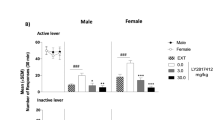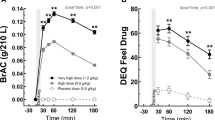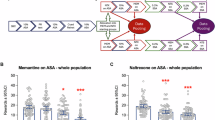Abstract
Distinct environmental and conditioned stimuli influencing ethanol-associated appetitive and consummatory behaviors may jointly contribute to alcohol addiction. To develop an effective translational animal model that illuminates this interaction, daily seeking responses, maintained by alcohol-associated conditioned stimuli (CSs), need to be dissociated from alcohol drinking behavior. For this, we established a procedure whereby alcohol seeking maintained by alcohol-associated CSs is followed by a period during which rats have the opportunity to drink alcohol. This cue-controlled alcohol-seeking procedure was used to compare the effects of naltrexone and GSK1521498, a novel selective μ-opioid receptor antagonist, on both voluntary alcohol-intake and alcohol-seeking behaviors. Rederived alcohol-preferring, alcohol-nonpreferring, and high-alcohol-drinking replicate 1 line of rats (Indiana University) first received 18 sessions of 24 h home cage access to 10% alcohol and water under a 2-bottle choice procedure. They were trained subsequently to respond instrumentally for access to 15% alcohol under a second-order schedule of reinforcement, in which a prolonged period of alcohol-seeking behavior was maintained by contingent presentations of an alcohol-associated CS acting as a conditioned reinforcer. This seeking period was terminated by 20 min of free alcohol drinking access that achieved significant blood alcohol concentrations. The influence of pretreatment with either naltrexone (0.1−1−3 mg/kg) or GSK1521498 (0.1–1–3 mg/kg) before instrumental sessions was measured on both seeking and drinking behaviors, as well as on drinking in the 2-bottle choice procedure. Naltrexone and GSK1521498 dose-dependently reduced both cue-controlled alcohol seeking and alcohol intake in the instrumental context as well as alcohol intake in the choice procedure. However, GSK1521498 showed significantly greater effectiveness than naltrexone, supporting its potential use for promoting abstinence and preventing relapse in alcohol addiction.
Similar content being viewed by others
Log in or create a free account to read this content
Gain free access to this article, as well as selected content from this journal and more on nature.com
or
References
Arroyo M, Markou A, Robbins TW, Everitt BJ (1998). Acquisition, maintenance and reinstatement of intravenous cocaine self-administration under a second-order schedule of reinforcement in rats: effects of conditioned cues and continuous access to cocaine. Psychopharmacology (Berl) 140: 331–344.
Augier E, Flanigan M, Dulman RS, Pincus A, Schank JR, Rice KC et al (2014). Wistar rats acquire and maintain self-administration of 20% ethanol without water deprivation, saccharin/sucrose fading, or extended access training. Psychopharmacology (Berl) 9: 114727.
Barker JM, Taylor JR (2014). Habitual alcohol seeking: modeling the transition from casual drinking to addiction. Neurosci Biobehav Rev 47: 281–294.
Carnicella S, Ron D, Barak S (2014). Intermittent ethanol access schedule in rats as a preclinical model of alcohol abuse. Alcohol 48: 243–252.
Ciccocioppo R, Martin-Fardon R, Weiss F (2002). Effect of selective blockade of mu(1) or delta opioid receptors on reinstatement of alcohol-seeking behavior by drug-associated stimuli in rats. Neuropsychopharmacology 27: 391–399.
Conklin CA, Robin N, Perkins KA, Salkeld RP, McClernon FJ (2008). Proximal versus distal cues to smoke: the effects of environments on smokers’ cue-reactivity. Exp Clin Psychopharmacol 16: 207–214.
Czachowski CL, Delory MJ (2009). Acamprosate and naltrexone treatment effects on ethanol and sucrose seeking and intake in ethanol-dependent and nondependent rats. Psychopharmacology (Berl) 204: 335–348.
Czachowski CL, Samson HH (1999). Breakpoint determination and ethanol self-administration using an across-session progressive ratio procedure in the rat. Alcohol Clin Exp Res 23: 1580–1586.
Czachowski CL, Samson HH (2002). Ethanol- and sucrose-reinforced appetitive and consummatory responding in HAD1, HAD2, and P rats. Alcohol Clin Exp Res 26: 1653–1661.
Davidson D, Amit Z (1997). Naltrexone blocks acquisition of voluntary ethanol intake in rats. Alcohol Clin Exp Res 21: 677–683.
De Bruijn C, Korzec A, Koerselman F, van Den Brink W (2004). Craving and withdrawal as core symptoms of alcohol dependence. J Nerv Ment Dis 192: 494–502.
Dilleen R, Pelloux Y, Mar AC, Molander A, Robbins TW, Everitt BJ et al (2012). High anxiety is a predisposing endophenotype for loss of control over cocaine, but not heroin, self-administration in rats. Psychopharmacology (Berl) 222: 89–97.
Drobes DJ, Anton RF, Thomas SE, Voronin K (2003). A clinical laboratory paradigm for evaluating medication effects on alcohol consumption: naltrexone and nalmefene. Neuropsychopharmacology 28: 755–764.
Economidou D, Dalley JW, Everitt BJ (2011). Selective norepinephrine reuptake inhibition by atomoxetine prevents cue-induced heroin and cocaine seeking. Biol Psychiatry 69: 266–274.
Everitt BJ (1990). Sexual motivation: a neural and behavioural analysis of the mechanisms underlying appetitive and copulatory responses of male rats. Neurosci Biobehav Rev 14: 217–232.
Everitt BJ, Robbins TW (2000). Second-order schedules of drug reinforcement in rats and monkeys: measurement of reinforcing efficacy and drug-seeking behaviour. Psychopharmacology (Berl) 153: 17–30.
Field M, Duka T (2002). Cues paired with a low dose of alcohol acquire conditioned incentive properties in social drinkers. Psychopharmacology (Berl) 159: 325–334.
Froehlich JC, Harts J, Lumeng L, Li TK (1988). Differences in response to the aversive properties of ethanol in rats selectively bred for oral ethanol preference. Pharmacol Biochem Behav 31: 215–222.
Froehlich JC, Harts J, Lumeng L, Li TK (1990). Naloxone attenuates voluntary ethanol intake in rats selectively bred for high ethanol preference. Pharmacol Biochem Behav 35: 385–390.
Gipson CD, Kupchik YM, Shen H, Reissner KJ, Thomas CA, Kalivas PW (2013). Relapse induced by cues predicting cocaine depends on rapid, transient synaptic potentiation. Neuron 77: 867–872.
Giuliano C, Robbins TW, Nathan PJ, Bullmore ET, Everitt BJ (2012). Inhibition of opioid transmission at the μ-opioid receptor prevents both food seeking and binge-like eating. Neuropsychopharmacology 37: 2643–2652.
Giuliano C, Robbins TW, Wille DR, Bullmore ET, Everitt BJ (2013). Attenuation of cocaine and heroin seeking by μ-opioid receptor antagonism. Psychopharmacology (Berl) 227: 137–147.
Goldberg SR, Kelleher RT, Goldberg DM (1981). Fixed-ratio responding under second-order schedules of food presentation or cocaine injection. J Pharmacol Exp Ther 218: 271–281.
Goldberg SR, Spealman RD, Kelleher RT (1979). Enhancement of drug-seeking behavior by environmental stimuli associated with cocaine or morphine injections. Neuropharmacology 18: 1015–1017.
Gual A, Bruguera P, López-Pelayo H (2014). Nalmefene and its use in alcohol dependence. Drugs Today (Barc) 50: 347–355.
Henderson-Redmond A, Czachowski C (2014). Effects of systemic opioid receptor ligands on ethanol- and sucrose seeking and drinking in alcohol-preferring (P) and Long Evans rats. Psychopharmacology (Berl) 231: 4309–4321.
Herz A (1997). Endogenous opioid systems and alcohol addiction. Psychopharmacology (Berl) 129: 99–111.
Ignar DM, Goetz AS, Noble KN, Carballo LH, Stroup AE, Fisher JC et al (2011). Regulation of ingestive behaviors in the rat by GSK1521498, a novel micro-opioid receptor-selective inverse agonist. J Pharmacol Exp Ther 339: 24–34.
Kaminski BJ, Goodwin AK, Wand G, Weerts EM (2008). Dissociation of alcohol-seeking and consumption under a chained schedule of oral alcohol reinforcement in baboons. Alcohol Clin Exp Res 32: 1014–1022.
Kelly E, Mundell SJ, Sava A, Roth AL, Felici A, Maltby K et al (2014). The opioid receptor pharmacology of GSK1521498 compared to other ligands with differential effects on compulsive reward-related behaviours. Psychopharmacology (Berl) 232: 305–314.
Koob GF (2013). Theoretical frameworks and mechanistic aspects of alcohol addiction: alcohol addiction as a reward deficit disorder. Curr Top Behav Neurosci 13: 3–30.
Krishnan-Sarin S, Wand GS, Li X-W, Portoghese PS, Froehlich JC (1998). Effect of mu opioid receptor blockade on alcohol intake in rats bred for high alcohol drinking. Pharmacol Biochem Behav 59: 627–635.
Lee JLC, Milton AL, Everitt BJ (2006). Cue-induced cocaine seeking and relapse are reduced by disruption of drug memory reconsolidation. J Neurosci 26: 5881–5887.
Ludwig AM (1986). Pavlov’s “bells” and alcohol craving. Addict Behav 11: 87–91.
Marchant NJ, Li X, Shaham Y (2013). Recent developments in animal models of drug relapse. Curr Opin Neurobiol 23: 675–683.
McBride WJ, Rodd ZA, Bell RL, Lumeng L, Li T-K (2014). The alcohol-preferring (P) and high-alcohol-drinking (HAD) rats—animal models of alcoholism. Alcohol 48: 209–215.
Milton AL, Schramm MJW, Wawrzynski JR, Gore F, Oikonomou-Mpegeti F, Wang NQ et al (2012). Antagonism at NMDA receptors, but not β-adrenergic receptors, disrupts the reconsolidation of pavlovian conditioned approach and instrumental transfer for ethanol-associated conditioned stimuli. Psychopharmacology (Berl) 219: 751–761.
Monti PM, Rohsenow DJ, Hutchison KE, Swift RM, Mueller TI, Colby SM et al (1999). Naltrexone’s effect on cue-elicited craving among alcoholics in treatment. Alcohol Clin Exp Res 23: 1386–1394.
Nathan PJ, O’Neill BV, Bush MA, Koch A, Tao WX, Maltby K et al (2012). Opioid receptor modulation of hedonic taste preference and food intake: a single-dose safety, pharmacokinetic, and pharmacodynamic investigation with GSK1521498, a novel μ-opioid receptor inverse agonist. J Clin Pharmacol 52: 464–474.
National Council on Alcoholism and Drug Dependence. Welcome to NCADD, at <http://ncadd.org/index.php>.
Niaura RS, Rohsenow DJ, Binkoff JA, Monti PM, Pedraza M, Abrams DB (1988). Relevance of cue reactivity to understanding alcohol and smoking relapse. J Abnorm Psychol 97: 133–152.
Nowak KL, Ingraham CM, Mckinzie DL, Mcbride WJ, Lumeng L, Li TK et al (2000). An assessment of novelty-seeking behavior in alcohol-preferring and nonpreferring rats. Pharmacol Biochem Behav 66: 113–121.
Panlilio LV, Yasar S, Nemeth-Coslett R, Katz JL, Henningfield JE, Solinas M et al (2004). Human cocaine-seeking behavior and its control by drug-associated stimuli in the laboratory. Neuropsychopharmacology 30: 433–443.
Rodd ZA, Bell RL, Sable HJK, Murphy JM, McBride WJ (2004). Recent advances in animal models of alcohol craving and relapse. Pharmacol Biochem Behav 79: 439–450.
Rohsenow DJ, Monti PM, Hutchison KE, Swift RM, Colby SM, Kaplan GB (2000). Naltrexone’s effects on reactivity to alcohol cues among alcoholic men. J Abnorm Psychol 109: 738–742.
Rösner S, Hackl-Herrwerth A, Leucht S, Vecchi S, Srisurapanont M, Soyka M (2010). Opioid antagonists for alcohol dependence. Cochrane Database Syst Rev (12): CD001867.
Samson HH (1986). Initiation of ethanol reinforcement using a sucrose-substitution procedure in food- and water-sated rats. Alcohol Clin Exp Res 10: 436–442.
Samson HH, Chappell A, Czachowski C, Sharpe A (2001). Measuring ethanol-seeking behavior: the effect of using repeated extinction trials. Alcohol 24: 205–209.
Samson HH, Sharpe AL, Denning C (1999). Initiation of ethanol self-administration in the rat using sucrose substitution in a sipper-tube procedure. Psychopharmacology (Berl) 147: 274–279.
Schindler CW, Katz JL, Goldberg SR (1988). The use of second-order schedules to study the influence of environmental stimuli on drug-seeking behavior. NIDA Res Monogr 84: 180–195.
Schneekloth TD, Biernacka JM, Hall-Flavin DK, Karpyak VM, Frye MA, Loukianova LL et al (2012). Alcohol craving as a predictor of relapse. Am J Addict Am Acad Psychiatr Alcohol Addict 21: S20–S26.
Simms JA, Steensland P, Medina B, Abernathy KE, Chandler LJ, Wise R et al (2008). Intermittent access to 20% ethanol induces high ethanol consumption in Long-Evans and Wistar rats. Alcohol Clin Exp Res 32: 1816–1823.
Smith SG, Werner TE, Davis WM (1977). Alcohol-associated conditioned reinforcement. Psychopharmacology (Berl) 53: 223–226.
Stewart RB, Gatto GJ, Lumeng L, Li TK, Murphy JM (1993). Comparison of alcohol-preferring (P) and nonpreferring (NP) rats on tests of anxiety and for the anxiolytic effects of ethanol. Alcohol 10: 1–10.
Tomie A, Sharma N (2014). Pavlovian sign-tracking model of alcohol abuse. Curr Drug Abuse Rev 6: 201–219.
Viglinskaya IV, Overstreet DH, Kashevskaya OP, Badishtov BA, Kampov-Polevoy AB, Seredenin SB et al (1995). To drink or not to drink: tests of anxiety and immobility in alcohol-preferring and alcohol-nonpreferring rat strains. Physiol Behav 57: 937–941.
Volpicelli JR, Alterman AI, Hayashida M, O’Brien CP (1992). Naltrexone in the treatment of alcohol dependence. Arch Gen Psychiatry 49: 876–880.
Wise RA (1973). Voluntary ethanol intake in rats following exposure to ethanol on various schedules. Psychopharmacologia 29: 203–210.
Ziauddeen H, Chamberlain SR, Nathan PJ, Koch A, Maltby K, Bush M et al (2013a). Effects of the mu-opioid receptor antagonist GSK1521498 on hedonic and consummatory eating behaviour: a proof of mechanism study in binge-eating obese subjects. Mol Psychiatry 18: 1287–1293.
Ziauddeen H, Nathan PJ, Dodds C, Maltby K, Miller SR, Waterworth D et al (2013b). The effects of alcohol on the pharmacokinetics and pharmacodynamics of the selective mu-opioid receptor antagonist GSK1521498 in healthy subjects. J Clin Pharmacol 53: 1078–1090.
Acknowledgements
This study was funded by Medical Research Council Programme Grant (no. G1002231) and by GlaxoSmithKline (GSK) that has a commercial interest in GSK1521498. The production of the P/NP and HAD rats was funded by the R24 Alcohol Research Resource Award grant (R24 AA015512) from NIAAA. Charles R Goodlett was funded by a grant from the IUPUI International Development Fund that supported his sabbatical leave at the University of Cambridge. Maria Pilar Garcia-Pardo was funded by Val+id para investigadores en formación (Conselleria de educacion, Generalitat Valenciana) that also supported her stay at the University of Cambridge (January–April 2014) as a visiting student. With this paper we would like to commemorate Daina Economidou who died in December 2012 after a heroic fight against lung cancer. The best way to remember her is to share with the scientific community her dedication and enthusiastic contribution to science through the data collected until a few months before her death, including the data in Figure 1. We thank Dr Larry Lumeng, Dr Richard Bell, and Rebecca Jane Smith at the Indiana University School of Medicine for facilitating the provision of the selected lines of rats; Dr Adam Mar for writing the program to analyze the EPM data; Dr Yolanda Peña-Oliver for analyzing the EPM data; Jing Xia for analyzing the blood samples; Sam Miller for excellent statistical advice; and Kristin Patterson and Ramprakash Govindarajan for providing the GSK1521498 solutions.
Author information
Authors and Affiliations
Corresponding author
Additional information
Supplementary Information accompanies the paper on the Neuropsychopharmacology website
Supplementary information
Rights and permissions
About this article
Cite this article
Giuliano, C., Goodlett, C., Economidou, D. et al. The Novel μ-Opioid Receptor Antagonist GSK1521498 Decreases Both Alcohol Seeking and Drinking: Evidence from a New Preclinical Model of Alcohol Seeking. Neuropsychopharmacol 40, 2981–2992 (2015). https://doi.org/10.1038/npp.2015.152
Received:
Revised:
Accepted:
Published:
Issue date:
DOI: https://doi.org/10.1038/npp.2015.152
This article is cited by
-
Sex dependence of opioid-mediated responses to subanesthetic ketamine in rats
Nature Communications (2024)
-
The neutral CB1 antagonist AM6527 reduces ethanol seeking, binge-like consumption, reinforcing, and withdrawal effects in male and female mice
Psychopharmacology (2024)
-
Total-body imaging of mu-opioid receptors with [11C]carfentanil in non-human primates
European Journal of Nuclear Medicine and Molecular Imaging (2024)
-
On the interrelation between alcohol addiction–like behaviors in rats
Psychopharmacology (2022)
-
Improving translation of animal models of addiction and relapse by reverse translation
Nature Reviews Neuroscience (2020)



